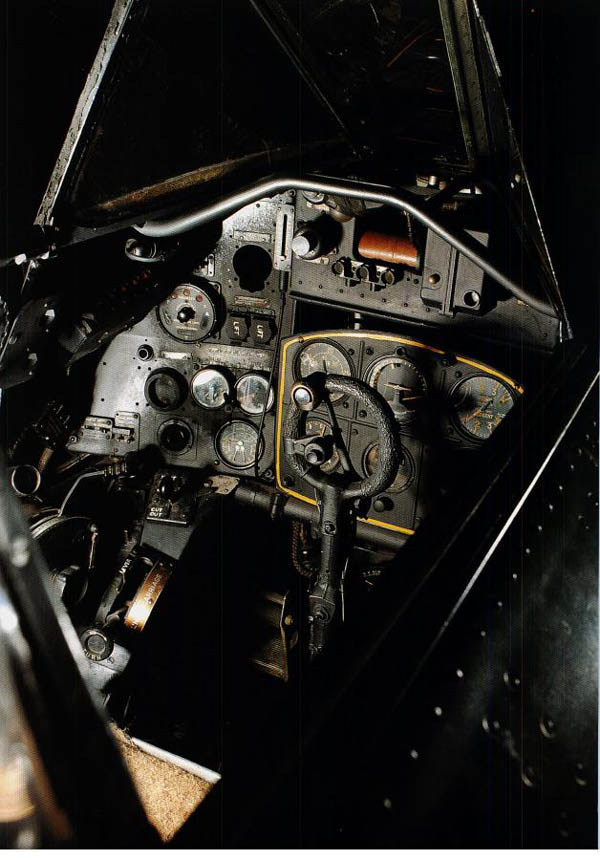The Dieppe operations in August 1942 was the first official combat use
of the RAF Typhoon, they bounced a formation of FW 190s south of Le Treport,
diving out of the sun and damaging three of the German fighters, but two of
the Typhoons did not pull out of their dive owing to structural failures in
their tail assemblies.
In November 1942 609 Squadron, led by Wing Commander Roland Beamont,
was moved to Manston in an attempt to combat the near daily hit-and-run
raids which were being made by Fw 190s and could rarely be intercepted by
Spitfires. The Typhoon enjoyed almost immediate success. The first two
Messerschmitt Me 210 fighter bombers to be destroyed over the British Isles
fell to the guns of Typhoons, and during the last comparatively ambitious
daylight raid by the Luftwaffe on London, on 20 January, 1943, five Fw 190s
were destroyed by Typhoons.
The Typhoon IB, affectionately known as the "Tiffy", distinguished
itself particularly in the Battle of Normandy, where it decimated a large
concentration of armour ahead of Avranches, disposing of 137 tanks, and
opening the way for the liberation of France and Belgium.
The only complete Typhoon
in the world is at the RAF Museum Hendon (UK): Typhoon Mk I B MN 235/FE491
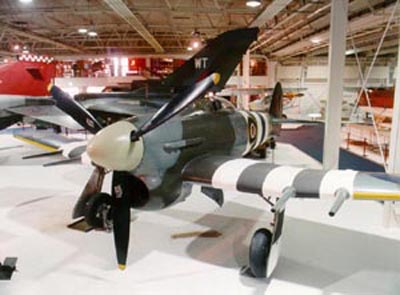
A Hawker
Typhoon IB with underwing bomb load and early cockpit hood.
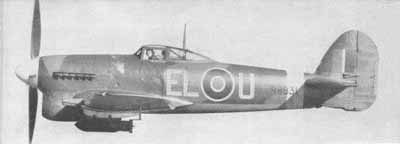
On November 17, 1942, Wing-Commander Beaumont had flown
a Typhoon on its first night intrusion over Occupied France and,
subsequently, the fighter was employed increasingly for offensive duties,
strafing enemy airfields, ships and railway transport. The success of the
Typhoon in the ground-attack role led to trials with two 250-lb. or two
500-lb. bombs which were carried on underwing racks. This load was later
increased to two l,000-lb. bombs, but the Typhoon was not to find its true
element until it was adapted to carry airborne rocket projectiles--four
under each wing. By D-Day, in June 1944, the R.A.F. had twenty-six
operational squadrons of Typhoon IBs. Without its underwing load the Typhoon
IB weighed 11,300 Ib.; and with two 500-lb. bombs and the necessary racks,
12,400 Ib. Maximum speed was 398 m.p.h. at 8,500 feet and 417 m.p.h. at
20,500 feet, and an altitude of 20,000 feet could be attained in 7.6
minutes. Between the prototype and production stages several design changes
had been made. These included the re-design of the fin and rudder, the
redisposition of the wheel fairings and the introduction of a clear-view
fairing behind the cockpit. On the first few Typhoon IAs the solid rear
fairing was retained; later a transparent fairing was fitted, but this was
abandoned in favour of the first sliding " bubble " hood to be used by an
operational fighter.
A late production
Typhoon IB with "bubble" type canopy
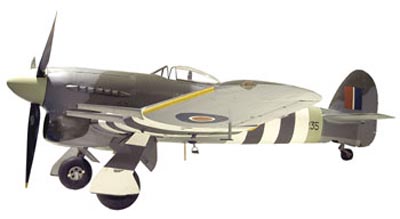
Work had been going on in the Hawker design office
since 1940 on the development of a new thin wing section. It had already
been established that the N.A.C.A.22-series wing section employed by the
Typhoon was entirely satisfactory at speeds in the vicinity of
400 m.p.h (instrumenty
pg 15). but encountered compressibility effects at higher speeds. In
dives approaching 500 m.p.h. a very sudden and sharp increase in drag was
experienced, accompanied by a change in the aerodynamic characteristics of
the fighter, which affected the pitching moment and rendered the machine
nose heavy. No actual design work on the new wing was begun until September
1941, and the wing section eventually adopted for development had its point
of maximum thickness at 37.5% of the chord. The thickness/cord ratio was
14.5% at the root and 10% at the tip, giving a wing five inches thinner at
the root than that of the Typhoon. This thin wing could not contain a
comparable quantity of fuel to that housed by the Typhoon's wing, so a large
fuselage tank had to be adopted. This necessitated the introduction of an
additional fuselage bay, increasing the overall length by twenty-one inches
forward of the c.g. This added length found its inevitable compensation
after initial prototype trials in a larger fin and tail plane. The wing area
was also increased, and an elliptical plan form was adopted, presenting a
chord sufficient to permit the four 20-mm. Hispano cannon to be almost
completely buried in the wing. All these modifications added up to a
radically changed Typhoon, but it was as the Typhoon II that two prototypes
were ordered in November 1941. However, in the middle of the following year
the name Tempest was adopted. Alternative installations of the Sabre engine
were designed for these prototypes; the first (HM595) had a Sabre II and a
front radiator similar to that of the standard Typhoon, while the second
(HM599) had a Sabre IV engine and wing leading-edge radiators.
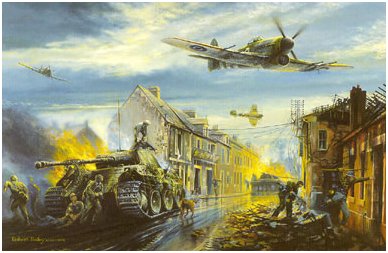
Piloted by Philip Lucas, the first prototype Tempest
was flown on September 2, 1942, but prior to this, in February 1942,
a production order had been placed and the first production machine flew in
June 1943 with Bill Humble at the controls. During flight trials the first
Tempest prototype had exceeded 477 m.p.h. in level
flight, and the first production model was essentially similar to the
first prototype with the chin-type radiator. This was designated Tempest V,
and the initial production batch, the Series I, had Mk. II cannon which
projected slightly ahead of the wing leading edge, but the
Series II had the short-barrelled Mk. V cannon
(pg 2aramanents) which did not project, and also featured a detachable rear
fuselage, small-diameter wheels and a rudder spring tab. Powered by a 2,420
h.p. Sabre IIB engine, the Tempest V attained a maximum speed of 435 m.p.h.
at 17,000 feet. The 820-mile range of the Tempest V in clean condition was
an appreciable improvement over that of the Typhoon, and was due not only to
the small additional quantity of fuel carried but to the aerodynamic
refinement of the later machine which permitted a higher cruising speed for
the same power.
The Tempest V was in the
hands of operational squadrons by April 1944, where it profitably carried on
in the low-level attack tradition of the Typhoon, which it was replacing as
Tempest production increased. However, in June 1944, the first German V-1
pulsejet flying bombs were launched against London, and the Tempest's
excellent low-altitude performance made it one of the preferred weapons for
dealing with the fast-flying little missiles. Tempest squadrons racked up a
considerable percentage of the total RAF kills of the
flying bombs.
Hawker Tempest V
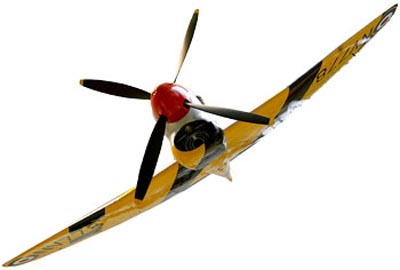
In the meantime, the Tempest continued strikes in support of Western
armies advancing across Europe, and engaged Luftwaffe aircraft when they
could be found. Tempests circling Luftwaffe airfields also scored a number
of kills on new German jets such as the Messerschmitt Me-262, which was
helpless on landing approach as its jet engines could not throttle up
quickly.
Hawker Tempest V
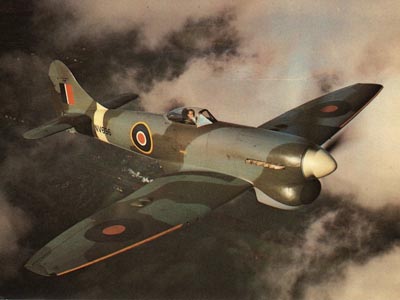
While Hawker was working toward the introduction of the Tempest V,
Sydney Camm and his crew were also revisiting the Centaurus radial engine,
incorporating it into two other Tempest prototypes.
The first Centaurus Tempest, or "Tempest Mark II", flew on 28 June
1943 with a Centaurus IV, and was followed presently by the second. The
radial engine installation owed much to examinations of a captured
Focke-Wulf FW-190, and was unprecedented clean and effective. There were
problems with vibration, but they were fixed by addition of six rubber shock
mounts.
Hawker Tempest II
PR536
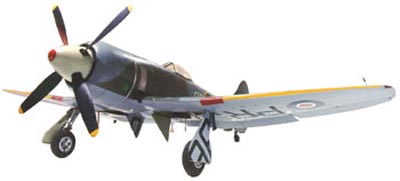
The Centaurus was generally regarded as superior to the Sabre,
particularly in terms of reliability, and the Centaurus engine and Tempest
airframe proved an excellent match. The combination looked so promising that
a contract for 500 of the type was placed as far back as September 1942, but
Gloster was overloaded with production of the Typhoon and development of the
Meteor, and there was no way the company could handle the additional load.
Tempest Mark II production ended up in the hands of Bristol, and the
switch delayed production even more. The first Tempest II was rolled off the
line on 4 October 1944, but then production was shifted back to Hawker.
Hawker Tempest II

A total of 452 Tempest IIs were built, including 136 basic Mark IIs
and 316 "Fighter Bomber Mark IIs (FB.IIs)". They were built mostly by Hawker
and generally with Centaurus V engines, and of that number 300 were
completed after the war. The Tempest II, despite its slightly improved
performance and better reliability, never saw combat. Tempest IIs produced
during the war were intended for combat against the Japanese, but the
Pacific War ended before they could be deployed.
89 Tempest FB.IIs were passed on from the RAF to the Indian Air Force
in 1947, while another 24 were passed on to the Pakistani Air Force.
* Various engineering refinements that had gone into the Tempest II
were incorporated into the last Tempest variant, the "Tempest VI", which was
fitted with a Sabre V engine with 1,745 kW (2,340 HP). Hundreds of Tempest
VIs were ordered, though only 142 were built. The last piston engine fighter
in RAF service was a Tempest VI, which was in use as a target tug when it
was retired in 1953.
Hawker Typhoon Cockpit
